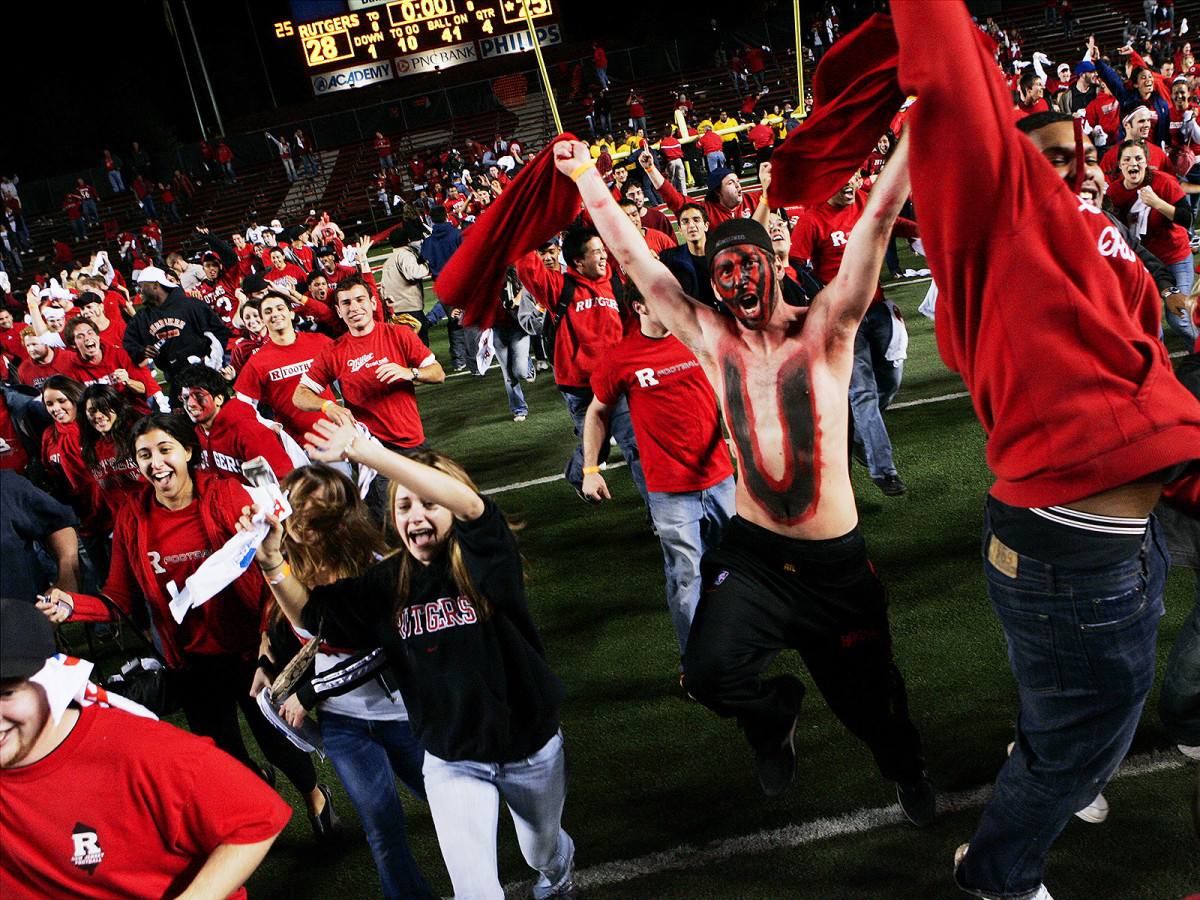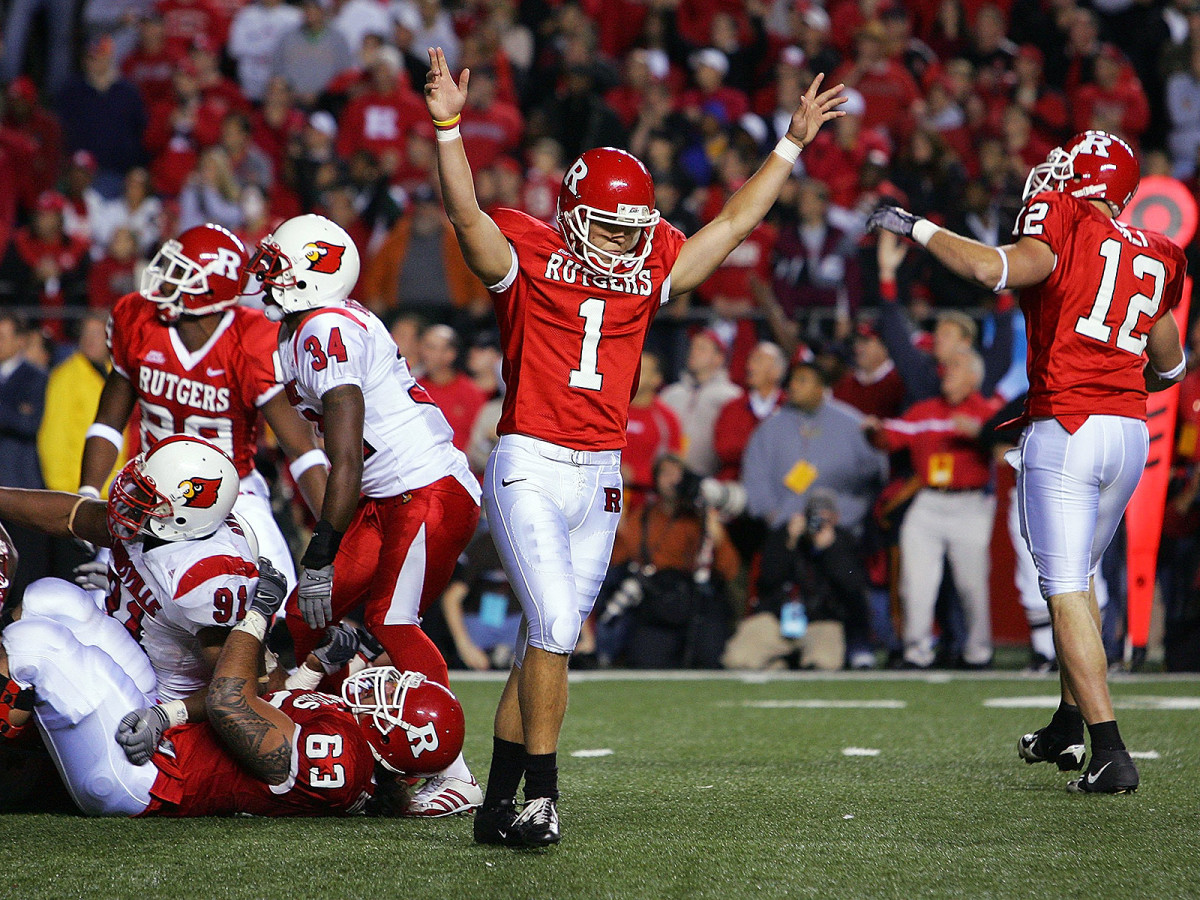Remembering the Night Rutgers and Louisville Were at the Center of College Football, 12 Years Later

Fans dubbed it “the Rebirth at the Birthplace.”
On Nov. 9, 2006, Rutgers and Louisville went toe-to-toe in Piscataway, N.J. Exactly 12 years later, with those programs representing two of the worst teams in America (Rutgers is 1–8, Louisville is 2–7), it’s tough to believe it was one of the marquee college football moments of the mid-2000s. In hindsight, for those involved—and those of us watching—it almost felt like a movie.
Synopsis
An undefeated Louisville squad, ranked No. 3 in the nation, marched into Jersey to take on the unbeaten No. 15 Scarlet Knights on a Thursday night, a primetime Big East matchup. Many considered it the most important game in Rutgers—and Louisville—football history.
Louisville, at 8–0, was fresh off a monumental home win over Pat White and then-No. 3 West Virginia the week before. High-flying junior quarterback Brian Brohm, the brother of then-quarterbacks coach and now-Purdue head coach Jeff Brohm, was en fuego. The Louisville offense was among the most feared in the country, and the Cardinals were a legit national title contender.
Rutgers was also 8–0, and for the Scarlet Knights, the game carried even more weight. Greg Schiano was orchestrating the rebirth of Rutgers football. It was his sixth year in town, and the previous 13 seasons had featured more one or zero-win seasons (three) than above-.500 seasons (one). For a historic program featuring dominant teams in the 1960s and 1970s, Rutgers football had hit rock bottom. The Scarlet Knights hadn’t even won against a ranked opponent since 1998. But in 2006, with an 8–0 record, a smothering defense and a thrilling sophomore running back in Ray Rice, Rutgers was back. To many around the program, the Louisville game was a re-introduction to the college football public.
RAGATZ: What's Better Than Guys Being Dudes? A Boston College Team on the Rise
Setting
A record—and raucous—crowd of 44,111 packed into Rutgers Stadium, which is known as the “birthplace of college football” (the first-ever college football game was played at Rutgers, a 6–4 win over the College of New Jersey). The giant crowd exceeded the stadium’s maximum capacity. A new set of bleachers was temporarily installed near the south end zone to accommodate student overflow.
Class was canceled. Rutgers students had been lining up since before 6 a.m. to snag tickets. The matchup also featured the third-largest TV audience in ESPN’s college football broadcast history—4.9 million households. Chris Fowler and Kirk Herbstreit delivered the call to the nationwide audience.
Act I
The crowd was deafening. The Empire State Building in Midtown New York City lit up Rutgers red. Miles west in Piscataway, it was a madhouse. Via SNY Sports:
But Louisville packed a punch to start the game, scoring the first touchdown. After the teams traded interceptions, we were treated to the first of many magical Rutgers offensive moments of the night: A 26-yard touchdown strike from Mike Teel to Tiquan Underwood. Tie game.
As if the first quarter highlight reel wasn’t packed enough, Louisville returned the ensuing kickoff to the house. JaJuan Spillman showcased blazing speed on the scoring run.
A Brohm touchdown followed shortly thereafter, and Cardinals were putting on a show worthy of Broadway—looking every bit like the No. 3 team in the land. A few minutes later, a field goal put them on top, 25–7. The unprecedented Rutgers hype was ready to fade into the background.
But just a few minutes before halftime, Rutgers struck back. A 39-yard rainbow connection from Teel to Kordell Young set up Rice for an 18-yard touchdown trot.
A turning point. Finally, Rutgers had grabbed some momentum, now down just 11.
“That really gave us a shot,” Schiano admitted postgame.
Rutgers players echoed their coach. As Schiano instilled in them, they kept chopping. Earlier that season, the veteran head coach implored his team to “keep chopping wood” as a motivational tactic. His troops learned to “live by The Chop,” repeating the phrase over and over during the magical season.
In the second half, Rutgers chopped right through Louisville.
Act II
Louisville had six full possessions in the second half. The Cardinals punted it six times. At one point, the vaunted Scarlet Knight defense forced four consecutive three-and-outs—against one of America’s most prolific offensive attacks. The Rutgers offense didn’t disappoint, either.
First, Ray Rice punched in a touchdown, and the ensuing two-point coversion cut Louisville's lead to just three. Rutgers’ defense continued to provide the juice, and Schiano’s kicker, Jeremy Ito (remember the name), banged through a 46-yarder with 10 minutes left in the fourth to tie it up, 25–25.
Another Louisville punt gave Rutgers the ball back on the Scarlet Knights’ nine-yard line with 5:00 on the clock: A tie ballgame, and 91 yards separating Rutgers from the biggest win in program history.
Teel and Rice, the backbone of Rutgers’ offense, powered a clock-chewing drive. Slowly, the Scarlet Knights marched down the field and into Ito’s range. With 21 seconds left, Rutgers had 4th & 7 from the Louisville 16-yard line.
Ito, the trusty-dusty field goal kicker, lined up for a 33-yarder smack dab in the middle of the field—a piece-of-cake chip shot for a kicker who made 76% of his kicks that season. The kick would forever live in Rutgers football lore—he missed badly.
But fortunately for the Scarlet Knights, an offsides penalty on one of the Louisville end men gave Ito a second chance. Next up, an even simpler 28-yarder.
Easy.
Ito booted it through, and the junior pointed sharply at the ESPN SkyCam above him. For the first time all night, Rutgers had the lead. With 13 seconds left, it was all but over.
Before a last-second Brohm Hail Mary attempt with :01 left, anxious Rutgers fans began to storm the field. To avoid a 15-yard penalty, they were shooed away quickly by officials. On the following play, when Brohm was sacked on a last-second heave attempt, pandemonium ensued:
Once down 25–7, Rutgers had stormed all the way back to steal a win. Seemingly 75% of the 44,111 at Rutgers Stadium spilled onto the field. The fan presence was so thick that some players feared for their safety, per NJ.com. The party in Piscataway was on.

Rutgers, then 9–0, was suddenly considered a national title contender. But it came crashing back down to earth a week later at Cincinnati. Away from the thrills of campus, the Scarlet Knights dropped a dud in Southern Ohio, a 30–11 loss to Brent Celek (yes, Brent Celek!) and the Bearcats. Rutgers finished 2006 as an 11–2 unit, also losing an overtime heartbreaker to West Virginia but then edging Kansas State in the Texas Bowl. The 11–2 season was the second-best in school history—not a national title as some fans had hoped the night of Nov. 9—but a season forever remembered for the thrilling Thursday night comeback against Louisville.
The Cardinals, on the other hand, won their last four games of the season. Louisville was back on the national stage a few weeks later, in an Orange Bowl win over Wake Forest. The heartbreaker at Rutgers went down as the 2006 Cardinals’ sole loss of the season—the only blemish on perfection.
LITMAN: Should Big Ten Have Buyer's Remorse Over Rutgers, Maryland?
12 Years Later: The Characters
The coaches and players who were at the center of college football on Nov. 9, 2006, are now scattered all over the map.
Bobby Petrino ditched Louisville the next season for the NFL, a one-year disastrous stint with the Atlanta Falcons. He then went to Arkansas to become head coach, where he was mired in controversy, including a motorcycle crash with a former Arkansas volleyball player and suspicious cash payments. He’s now back at Louisville, in the midst of a trying 2018 season.
Brian Brohm was drafted by the Packers in the second round of the 2008 NFL draft, and he bounced around the NFL and CFL before becoming quarterbacks coach at Western Kentucky in 2016. He’s now the co-offensive coordinator and quarterbacks coach at Purdue, under his brother—and head coach—Jeff Brohm.
Harry Douglas, a Louisville receiver who amassed 97 receiving yards in the Rutgers clash, was an Atlanta Falcons receiver from 2008–14, where he caught a career high 1,067 yards in 2013. He last played in 2017 in Tennessee, just a few hours from Louisville.
Greg Schiano’s name has been newsworthy for years now. He’s currently the defensive coordinator at Ohio State, and he controversially surfaced as a serious candidate for the Tennessee vacancy last year. Volunteer fans resisted en masse due to Schiano’s ties to the Penn State scandal involving Jerry Sandusky. In 2012, Schiano moved to the NFL to coach the Tampa Bay Buccaneers. They fired him after a 4–12 season in 2013.
Mike Teel was a sixth-round draft selection of the Seattle Seahawks in 2009, but he never played during the regular season. After leaving the NFL a year later, Teel eventually returned to Rutgers as a graduate assistant in 2014. Now, he’s the head coach of New Jersey high school powerhouse, Don Bosco Prep, his alma mater.
After rushing for over 6,000 yards and 37 NFL touchdowns in six seasons for the Baltimore Ravens, Ray Rice was disgraced from the league after an Atlantic City casino caught him on camera punching his then-fiancée in an elevator. Since the release of the video, Rice hasn’t played an NFL snap.
Jeremy Ito was signed by the New Orleans Saints in 2008, but the kicker was released before the season. He kicked a bit in the CFL. He now works in the investment management industry.

12 Years Later: The Programs
Flash forward to 2018, and things have turned ugly for both programs. Rutgers is 11–34 over its past four seasons. In 2016, the Scarlet Knights were blown out by a combined score of 224–0 against the powers of the Big Ten East: Ohio State, Michigan State, Michigan and Penn State.
Now under the direction of Chris Ash, Rutgers is 1–8. It's scoring 15.3 points per game (fewest in the FBS) and giving up 33.4 per game. Freshman quarterback Art Sitkowski is the nation’s leader in interceptions, and he had a 2 for 16, four-interception outing against Maryland in October. Before the disastrous season even started, eight Scarlet Knights were charged in a credit card fraud scheme. And last week, a linebacker was charged with attempted murder.
Louisville, just two years removed from Lamar Jackson’s awe-inspiring Heisman campaign, is 2–7. Petrino is back in town for his second stint with the Cardinals, and now many are calling for his firing. This year, Louisville has allowed Alabama to post 51 points, Georgia Tech to run up 66 on 542 rushing yards and Clemson to pour in 77 points on Petrino’s boys last Saturday. The Cardinals are likely in for their worst finish this millennium. Louisville radio host Mark Ennis reported that, this fall, 20 Cardinals players have requested paperwork to transfer.
Twelve years ago, Louisville and Rutgers were Big East rivals vying for undefeated seasons in one of college football’s most memorable games of the decade. Now, Big East football doesn’t exist. Louisville is still trying to find its way in the ACC, guided by a once-disgraced and likely soon-to-be-canned Petrino. Rutgers is the laughingstock of a Big Ten conference based hundreds of miles West of its campus. Combined, the teams are 3–15 this season, and they’ve been outscored, 668–332.
But for one Thursday night in November, Louisville and Rutgers were the toast of college football.
Oh, how the mighty have fallen.
